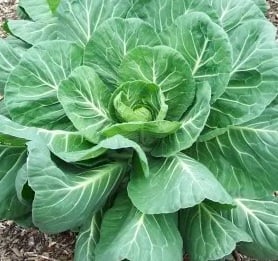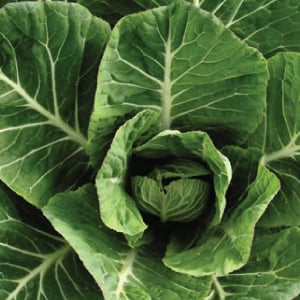
Learning Download: How to Grow Collards
From Seed to Harvest: A beginner’s guide to growing collards.
Collards are a leafy plant similar to kale in the way they grow and taste, and the plant prefers cooler weather. All collards are green, and look similar to cabbage plants without the snowy head in the middle. Though collards are typically associated with the south as a popular side dish, the plant does well in cooler climates.
To plant
Since collards are a cool-weather plant, they are planted in late summer or early fall for a winter harvest in the south. In northern climates, plant collards a little earlier for a fall harvest. For a spring harvest, begin seeds indoors four to six weeks before planting outdoors. Transplant the seedlings outdoors three weeks before the last frost date. To prevent overwatering from spring rain, plant the spring crop in a raised bed. To prevent clubroot disease in the future, do not continuously plant Cole crop vegetables in the same spot each year.
To grow:
Plant collard seeds in rows set 3 feet apart and thin seedlings to 18 inches apart. The thinned seedlings can then be added to salads or other dishes. Aphids and cabbage loopers can be a problem to collards, so place a screen over the plant in its early growth to prevent the cabbage looper moths from layering eggs.
To harvest:
Collards generally take 75 days to reach maturity, but the leaves can be harvested before. Plants can be harvested and cut to ground level when they reach 6 to 10 inches in height, or you can pick the individual leaves based on size preference.
Collards have a better flavor after withstanding a few frosts, and they can tolerate temperatures into the upper 20s.
What collards crave:
Collards need full sun, but they can be planted in poorer or average soils. To discourage clubroot disease, plant in soils with a pH of 6.5 to 6.8. Water 1 to 1.5 inches per week.
Where to buy collard seeds:
You can find different varieties of collard seeds at Urban Farmer.
Learning Download: Common pests and diseases: Collards
Common pests and diseases: Collards
When growing vegetables, it is always exciting to care for the plant throughout its growing phase and then harvest it for delicious recipes later on, but one thing to watch out for is pests and diseases. Different plants are susceptible to different types of pests and diseases, and it is important to make yourself aware so you can keep a watchful eye and also take any preventative methods to keep your plants safe throughout their lifespan.
Collards can fall victim to several different pests and diseases.
Pests:
When grown in the home garden, collard greens can fall victim to two major pests, which are aphids and the imported cabbage worm.
Aphids are soft-bodied, small insects that are mostly attracted to the newer growth. These pests suck out the tender leaves’ juices and causes them to become stunted. You can determine if aphids are infesting your collards if there are clusters of small green insects on the back sides of the leaves. Spray these off with a hose.
Imported cabbage worms will mostly attack members of the cabbage family. These are the larva of small white butterflies, and they can damage plants by eating through the leaves. Handpick the adult caterpillars off the leaves, and if you notice the small white eggs on the back sides of the leaves, brush those off as well.
Diseases:
Diseases aren’t as common in collard greens if the collard is planted in healthy soil, but diseases can still cause issues in collard greens.
Clubroot, phytophthora root rot and verticillium wilt are all fungal diseases that can cause stunted growth and yellowing of the plant’s lower leaves. Isolated brown or yellowing spots on the leaves may also be a symptom of a disease attacking your collard greens. These pathogens attack the roots of the plant, so you must uproot it for a diagnosis.
Gardeners are encouraged to manage diseases by utilizing preventative methods, such as crop rotation. By utilizing crop rotation, it will prevent the build-up of certain pathogens that can later on harm your plants.
If you notice a plant with symptoms of diseases such as yellowing leaves or stunted growth, pull it out of the ground and discard it properly, do not place it in the compost pile because this could spread the disease even further.
Collard greens also can fall victim to other diseases, such as certain kinds of leaf spot, which can lead to defoliation if the infestation is severe enough. To manage leaf spot, be sure you are planting disease-free seeds, avoid overhead watering and again, utilize crop rotation in which you don’t plant members of the brassica family in the same spot more than once every two to three years.


